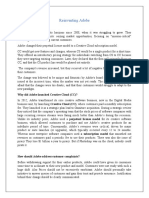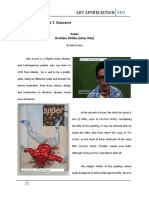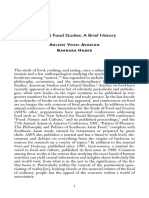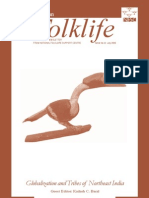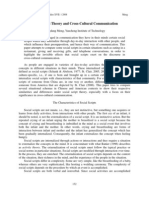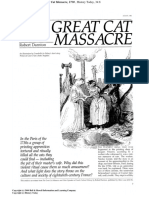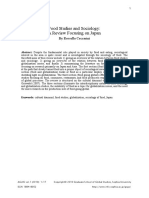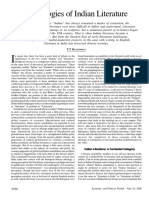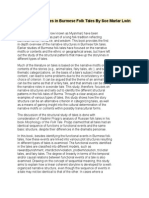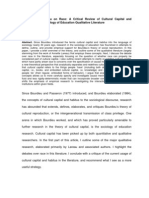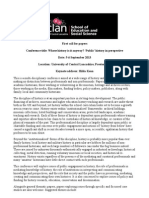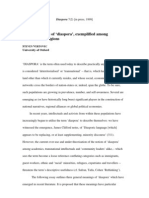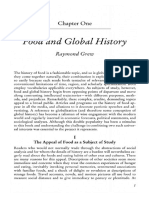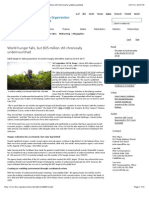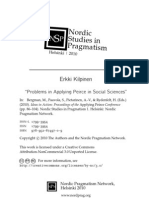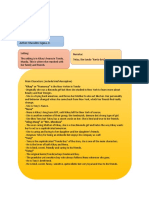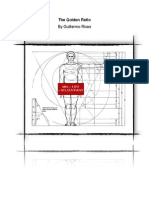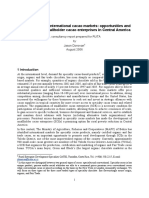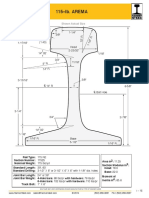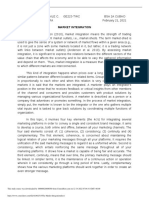100%(1)100% found this document useful (1 vote)
148 viewsThe Discourse of Food
The Discourse of Food
Uploaded by
nllanoMedia discourse of food.
Copyright:
Attribution Non-Commercial (BY-NC)
Available Formats
Download as PDF, TXT or read online from Scribd
The Discourse of Food
The Discourse of Food
Uploaded by
nllano100%(1)100% found this document useful (1 vote)
148 views10 pagesMedia discourse of food.
Copyright
© Attribution Non-Commercial (BY-NC)
Available Formats
PDF, TXT or read online from Scribd
Share this document
Did you find this document useful?
Is this content inappropriate?
Media discourse of food.
Copyright:
Attribution Non-Commercial (BY-NC)
Available Formats
Download as PDF, TXT or read online from Scribd
Download as pdf or txt
100%(1)100% found this document useful (1 vote)
148 views10 pagesThe Discourse of Food
The Discourse of Food
Uploaded by
nllanoMedia discourse of food.
Copyright:
Attribution Non-Commercial (BY-NC)
Available Formats
Download as PDF, TXT or read online from Scribd
Download as pdf or txt
You are on page 1of 10
At a glance
Powered by AI
The document examines how mass media diffuse meanings and values attached to food preparation and consumption, reproducing lifestyles as a cultural frame of reference.
The document examines the public discourse about food in newspapers and magazines.
The author sees food as having both material and nonmaterial aspects that convey particular meanings and experiences beyond just nutrition.
Mass Media and Lifestyle Differentiation:
An Analysis of the Public Discourse
About Food
Robert Hanke
Villanova University, Villanova, PA
Thi s essay examines the publi c di scourse about food in The Philadelphia Inquirer and Philadelphia
Magazine. Anal ysis uf changes in American food j ourn alism reveals the popul arization of
gastronomy and the promotion of conspicuo us culi nary consumption. These changes do not merely
reflect changes in publ ic tastes in food an d coo king, or social st ruct ure; ra ther, it is argued that
the mass media diffuse the meani ngs a nd va lues that are a t tached ( 0 the prepa rati on and con-
sumpt ion of food, and di spl ay the choices to be made in this do main of aesthet ic cons umption ,
the reby reprod ucing " lifestyles" as the dominant cultur al fra me of reference for the orga niza-
tion of eve ryday ur ban life.
" Food has cha nged from just being fuel. Now it ' s news, fun , sex, en tertainment , sel f-expression
a nd art. ... Food has repl aced sex . "
La urel Cutler of FCB/Leber Kat z
Pa rt ners. a marketing consultant finn in New York
Introduction
In Robert White's (1983) assessment of the various approaches that have been
taken to the rel ationsh ip of mass communication to culture, he concludes that
we lack a more general theory of social communica tion which accounts for the
mutual " inte rac tion of change in social structure, change in communication
patterns (incl ud ing reorgani zation of th e mass media), and change in culture"
( 1983:296). Such a theory, I believe, would help us to overcome one of the ma-
jor shortcomings of more tr aditional approaches to mass communication: the
222 R. HANKE
idcnrificauon of media cu lture with ' "lived cult ure", 'vulture making" activitie-s ,
and emerge nt form s of " public culture >. 1 It would a Uow us to beRin to reco nccp-
tual ize the role of the media-e-to see medi a not in functi on alist terms as a"WllIs
of socializa tio n or social control but a.. one of the domi nant sites of symbo lic
production involved in the larger dyn amics of cultura l product ion, re- product ion
and consumption. O ne avenue of approach that shows promi se is sucgested by
William Lei ss rl al. (1986) in their study of advertising discourse as a vehicle
of social communication . One of the strengths of thei r analysis is the incorpora-
tion of the anthropological insight that goods are primary rar riers of mea ni ng
in a ll societies. inc luding consumer society.
As a case in point, consider food . Like buildings. dress , and music. food has
bo th material and nonmaterial aspects that conn'y particular meanings and I:X'
periences. Foodstuffs in capi talist societies are not only commodities that an'
produced and exchanged to satisfy our biological nee-ds: food is one of society's
symbolic idioms, appealing to all the sensory modalities through vat iarions in
taste, texture, aroma, sound, and visual appearance, often conveying impres-
sions and associations that words are incapable of expressing in the immediate
context of use . The study of food as a medium of social discourse has primarily
been the domain of symbolic anthropologists. employing structuralis JX'r.;pec-
rives. in order to analyze the meaning of food habits and to identify the codes
that structure the discourse throu,(h food. In this vein. the work of Le-i-St rauss
and hi s followers, particularly Ma rshall Sahlins (1976) and .\Ia ry l.Ioualas (1972;
1976: 1979 : 1982), have provided the of a culrural theo-v of pro-
duction and consumption that enables us [0 see how cultural goods, such as
food, communicate symbolic meanings. Other scholars, working from wry di f-
fere nt pe rspect ives. have also dt'monslralt,d that the meaning" of foo,J cx u-nds
far beyond rhe situation in w hich it is prepared and consumed {Barthes 1961 ,
J erome 1970, Berger 1981, (;uody 1982, .\ Iurcott 1983, Helasco 1984, Herger
1985 .\1intz 1985).
Fa r less att ention has IXTn given 10 the pu blic di scou rse about food althou gh
it would appt'ar to be a r ich area within which to reline our understanding of
what Lei ss rl al. have called the "discourse through and about Ol)jl'ns" ( 1986 :3).
Thi s study of the discourse about objects begins with the observation that the
mass media are cultural inst itutions rhar embody perspect ives which den- nni ne
how information on va rious aspec ts of urban living an: selected an d tldirwd (Snow
1983). As Rub en Snow a rgues, medi a culture is interpretive cult ure, activ ely
att r ibuting meani ng and sense to var ious aspects of ever-yday lifi-, including cook -
ing and eati ng. From th is it follows that the pu blic discourse 0 11 the subject of
lood and cooking ca n studied as a source of about lood ha hits,
culi na ry pract in's, and Ihe meanings an t! val ues that are allached 10 f()(xl a nd
its preparation and consumption.
2
\ \' hereas Lei ss rl al. ( 1986) see advcrtis ing
MASS MEDIA AND FOOD 223
a s the pr ivileged form of discourse abou t the world of goods, and market in g
and advertising age ncies as the ch ief ma tchmakers between goods and consumer
g-oods or taste-s, less concent ra ted, bUI no less interes ring , infor mal ion about
the- world of goods is a lso avuilabb- ill tlu- various genres of u rban journ alis m.
In this essay, I will examim- tlw diM'oul'SI' about food , focusin g in particu lar on
shifts in the editorial content and stylt' of food-relau-d e-ommentarv in American
metropolitan newspapers and city magazines.
The Popularization of Gastronomy
Even a cursory reading of the food pages of many metropolitan newspapers
suggests that food has com,' into its own as a topic of discussion. In the early
196Os, food. as far as TIv Philadrlphia I"qui," was concerned. was a subject th at
received limited anennon by todav's standards.' Recipe-o riented coo ke flo' col-
umns could be found in a separate section containing advertisements of food s
which women readers might purr-haw and wen- almost enrirely devot ed to din-
ina at home. The overall emphasis in these pages was on domest ic cookery-
"economical", "convenient. ' and " substantia l" dishes that would be ap-
propriate for family meals. Wnmt'n, as traditional home coo ks , were addressed
as housewives operating withi n the const ra ints of a domestic economy of ti me,
money, and etlort . T he preponderance of "do-able" recipes thus symbolized
the traditional conception of women in the sexual division of labor. Attentio n
to ease of preparation and the use of " convenience " foods thus spoke to a par-
ticular social rendit ion. inasmuch as coo king was a routinized ac t ivit)" r onv en-
rionally assnciah'd wit h .....oman's role- in the family.
T he dishes that n-sulred from following the recipes presented were go...e med.
in large rneasurr, by a pracucal, functional aesthetic. T his aes thet ic, promoted
by home economists. made a virtue out of necessity by assoc iat ing the goodness
of food wi th an eco llomy of ti me an d effort . This aes thetic avoids compl icated
metho ds of fnod prepara tion nOI only for ordinary, weekday, family mea ls, but
also on "vpccial occas ions" when are being ent ertained. Even though
suc h occasions lIlay call for "gourmet" rookery, the overriding conce rn is for
simplicity, reducing rlu- li"w spe nt in the kitchen , an d sav ing money. The
"casse role' " a d ish that take-s its nanu- from the conta iner it is cooked in rather
tha n the ingredients, is perhaps the consummate symbol of mi ddl e-class domes tic
rooke- ry at this ti me, since it could be assembled in a short ti me, pl aced in the
O,"TTl and h-It unat tended unt il it was " coo kt' d" and ready to t'a l.
11 is also appan' [l[ in tht'!'i(' pages tha I the kitchen is a place for women' s work.
a place when' women l"ngagt' in routine ta sks rela ted to provi ding meal s for
th(' re st of the fami ly. It is not surprising that kitchen equipment or foods that
224 A. HANKE
reduce preparation time and effort an" recommended as ways to "escape" the
tedious a spects of preparing mea ls on a daily basis. In th is rega rd, it is "ronv_
en jcm-e" foods, the products of large-scale food manufacturcrs , that eli minate
most or all coo ki ng pron ss(s. It is a lso interesting- to note that the prescribed
use of premixed a mi pr ecooked foods tr an sforms coo king as an at"sthet ic ex-
per ience in ilsdf to a bundle of tasks that must be performed accordi ng to
manufac turers directions. In Illall y cases, as with canned soups, T V dinners,
Ir07-"n and instant foods, li nk- skill or sens itivity to cooking materials is demandt. "d;
cooking is simply a matter of addi ng liquids and/or heating up the product to
{he desi red tempe rat ure. This con ception of cooking is consisrem however with
an overal l pe rspccuvc that coo king as a repetitive and routi nized (a nd
somet imes burdensome) tas k rather than a fonn of individual creativity or a
way of "t' lll ertain ing" or im pressing others.
T hus food nllunu'ntar)' in the early 1960s appears to reflect particular condi-
tions of dOIlU'slic existenre. The common meal is represented as a priva te affai r
and women arc assu med to be respons ib le for purchasing and prepa ring the
foods that .... ould be: eaten by the rest of the famil y. The style of do mestic rookery
represented by the food pages wa s thus well adapted to the socially patterned
schedules and expectatio ns uf the hypotheti cal , classless, nuclea r family. In this
wav, food cou unen rary symbolized a family-centered lifestyle and a definit ion
of the siruaricn co nce r ned with domesti c rout ines and the interrelat ions hip s of
Iamilv members.
A of gradual yet subs ta ntial cha nges in the ed itorial content and styl.e
of the food pa ges too k place durin g the 1970s. First and foremost was addi-
t ion of a sepa rate sect ion de voted to food in the Sunday -:plae mg
" Food and Famil y" sect ion of the Sunday magazine. Al ong .....ith mfonll.alLon
abo ut " thi ngs to do" and " places to go" , readers could al so expec t find a
different restaurant reviewed each ..... eek in the "This Wee ken d " secuon. ,
New syndica ted columns began to reflect a growing interest in ' :gourmet'
food . Among these were pieces byJ ames Beard, the " Dea n of C(xlk-
, I inen b I l ..... mcmd
ing" ; " Gourmani a Guide , " a syndica ted co umn wntten y a ,
. . . .. 1 '" disb [ I' 'ry tradi tions a round
food connoisseu r featur ing c ussic 1:O;.IIes rom cu rna ,
, , . I d
the world ; and " T he Fast Gourmet. " James Beard, for exa mple,
, " h h hi , d t " "' 0 "scene-s 01 cnung a "gourmet" sensihiliry t mug IS recipes an perso na re I . ... ' .
- diff .. f cui int hi h an d 10..... In favor
experiences. He rejected the urerennanon 0 cuisine In 0 lIg .
. ... H inc that ! rh - m a nner of sell-cli ng
of a more egalitarian view. y sugge st ing t at Il .....as e "
!
". . " gourmtt
and preparing food, rather than absolute cost , that .....as oecrsrve m .
od
-Iy a nel'esslly
cookery, Bea rd promoted th{" awa rene ss that fo ..... as not men .
, " [ . -day at's t het IC
(and eating only functIOnal and ob ligatory) but a source 0 e,er), . __,
, ' I not oPPOS('U
pleasure. Heard ' s brand of culina ry popuhsrn was, consclousy or , . _
, , , k' Iting more ,It
to food" snobbe ry" at a time when sophlst lcaled coo mg was ge .
tent ion by the po pular a nd specialiZt'd media, including the InqUl rtT.
MASS MEDIA AND FOOD 225
The representation of specialized techniques (inclUding ways of transform-
ing ordinary foods into "goUflllt.'t" d ishe s as sugges ted by the title " Simple
Cha nges Transform a Bed Stew int o Deli ciou s French Ragout de Hoeuf"},
reci pes for " fanc y" dishes (excer pts from J ulin Child's Kitchen), making hints
from profession al chefs, the "popularity" of and t a ste for " fore ign " foods, the
discussion of ..... ine as a n accompa niment to food (a rq.,'Ular column devoted to
wine appeared in 1973), all indica te that the who le realm of cookery- recipes.
appl icat ions, usag-es-represent ed by the Inqui" , Ix"gins to reflect the em(' rgence
of u rban lifestyles where the cultivation of sophist ication in matters of food a nd
drink was cr uc ial. As at tention 10 gourmet ethnic cooki ng, and the
ac tivit ies of re staurateurs a nd professio nal chefs invoked in the field of small-
scale. "special ty" restaurants incr ea ses, the tone of practical materialism thai
characterized food commentary in rhe 1960s gives way to a gourmet sens ibility.
There are a number ofot her indications thai attitudes towar ds food and cooking
were changi ng. In the first place. food began to be seen as a "ser ious" subject
for discussion. As one senior food ..... riter observed:
I started !otd1ing serious ahnur lOad .... ith F.M"Uffio:r and CWl my perspective was IlO\ that of a bousewife
bul more a'5 someone woo was a sophrsncared of food with !tIC' pranicaJ of
being a homemaker.
T his comment reveals a more er udite altit ude to..... ards food, includ ing Ihe pro-
pensity to cuhivate a semi-scholarly knowled g{' of the culina ry achi evement s
of the past a nd the t rad itions of the "great" cuisi nes of the world. The mere
invocation of Escofli er, who was responsihle for modernizing and cod ifying
"classic" French cooking and is considered to be the "g-rea test culi nary artist
of the modern a ge , " indicat es the way in which lOad and coo king began to be
thought out by food journalis ts. t
Besides this fundamental shift in pers pec tive, food began to be seen as an
increasingly " newsworthy" field . In order 10 bring mo re concentrated atten-
lion to the subject of food , the full-rime ..... ri tin g st all was gradually expanded
and each writer's assignment s were made so that areas of specializat ion could
be developed..More food -r ela ted features of cu rrent interest were und ertaken.
Food writ ing began to ado pt the fam iliar soft new s, local-angle perspecti ve rhat ,
among ot he r things reflected the l nquirer's attention to the rev italization of pu blic
culinary cu lture known as the " Philadelph ia restaurant renaissance'" .!
During the 1970s , the content of the food pages gradually shifted to include
stories wrillen from all " inves t igative" perspe ctive. "News..... onhiness " and
" timeliness" rn..'Came (Titeria for the accqltahilit y of infonnalion. More and more
info r ma tion began to be allributed to sources in the restaurant bu siness.
especially people involved in ne..... establishments. T he nature of these writing
assignments made il ne cessary for writ l:' fS to spend time in the "field" and to
226 R. HANKE
develop a network of local sources. Direct quotation of these sources both reflected
the writer's "ins ide r " status in the restaurant "world" and enhanced the status
of those quoted. Despit e thi s " news " emphasis, however, most reporting on
restaurants is of the " human int erest " variety, a way of organizing goss ip abou t
the peo ple invol ved in the rest aurant busin ess.
By the 1980s, the first page of the Sunday food sect ion announced that it con-
tained " Recipes and news about good food , go ur met cooking, and fine wine ."
We ca n get a bett er ide a of the cur rent state of the field of food journalism by
examini ng the na ture of a sen ior food wri ter ' s ass ign me nts .
The prima ry task of a food write r is to rep ort on food-rel ated topics of in -
te res t to a general , metropolitan readershi p . Feature ar t icles vary from week
to week and may be event , person, or holiday or iented. Unlike the recipe col-
umns of the past, these art icles offer more " backgro u nd" information in the
form of bi ographi cal, h istorical , or cu ltu ral det ail s.
Al on g with a personal colu mn, this writer also has three regul ar assignments
that appear under the same heading each wcck- "Criti c' s Choice , " " Dining
Out, " and " In a Hur ry. " "Critic's Choice" is a periodi c se ries devoted to
the presentation of an " or iginal" recipe by a local professional che f. It represents
a di stinct modalit y of culinary pr actice-cooking without counting time or mo ney.
This series, more than any other, articu lates the d ist inctions and di scrimina-
tio ns that professio na l chefs rout ine ly make and that read ers might be in terested
in rather than inclin ed to overloo k or ignore.
Evidentl y, the audience for these kinds of reci pes gre w during the 1970s as
people took up coo king as a pastime or hobby. This concept ion of cooking an d
the int erest it implies in th e techniques and methods of specialized coo kery
(demanding a great investment of time and interest) symbolized the emerge nce
of lifestyles where " gourmet " coo kery was regarded as an engross ing and sat is-
fyin g thing to do in one 's spare time. Gourmet coo king is a dimen sion of what
Hen ri Lefebvr e ( 1958) calls "cultured leisure ." It is an "art" th at is not u ndif-
ferentiated fro m daily life, name ly coo king and eati ng, yet it man ifests the at -
titudes of personal, highly specialized occupations and hobbi es requiri ng technical
skills. This analysis should not suggest, however, that the re lat ionsh ip of cook-
ing to ge nde r has changed very much . Thomas Adler suggests that mal e in-
vol vement in coo king has incr eased, but the regul ar pattern of cooking by men
conta ins elements of a symbolic inv er sion: " his is fest al , hers is fcr ial ; his is
soc ially and gastronomicall y expe r imental, hers mundan e; hi s is dish-specific
and temporally marked, hers is di versifi ed and quot id ia n; hi s is pl ay , hers is
work" ( 1983 :5 1).
" In a Hurr y" , the writer's second standing column, discusses d ishes that
ca n be prep ared in less than an hou r without making use of conven ience foods.
Al on g wit h a colu mn by anot her staff wr iter called " Affordable Feast " , these
MASS MEDIA AND FOOD 227
two colu mns represent a mod al ity of culinary practi ce (q uickly and cheaply)
that stands opposed to " gou rmet " or " ethnic" cookery (which demands a greater
invest ment of time, money, and int er est ). Interestingly, these columns are al so
believed to represent the " kind of cooking people really do" even thou gh they
clearl y fa vor the utili zation of raw foods and cooking " fro m scratch" ove r the
use of industriall y-processed, convenience foods that most people consume.
Fin all y, the writer is also the Inquirer's regular restau rant cr itic and is thus
res pons ib le for a weekly" Dining Out " column. Although the titl e of " cr iti c"
suggests that " Dining Out" columns are a forum for di sseminating cr it icism,
the lack of fixed crite ria of evaluat ion (suc h as those a pplied in the cr it icism
of the fine arts or eve n the popul ar arts) , the mult ipl e reason s people have for
patronizing a pa rti cul ar establi sh men t, and the need to wri te for a genera l au-
d ience means that va lue j udgements and " rat ings" that would rank a restaurant
accord ing to quali ry are avoide d. T ypi call y, the reviewer not only describes the
di shes sa mpled and pri ces but also comments on the decor , serv ice and the kind
of people who appear to patroni ze the est ablishment.
This tendency towards spec ialized features or columns is also evident in the
kinds of ass ignme nt s taken on by other staff writers. One cont r ibu tor, for ex-
ample, explored spec ific ingred ien ts; another special izes in the international reper-
toire of di she s and method s of preparation . Alon g \v ith recipe s, writer' s occa-
siona lly advocate the kind of " creat ivity" a nd free dom of maneuver prized by
pro fessional chefs:
For an inventive coo k. the tech niques invol ved in producing a tr ied -a nd- true lasagna reci pe ar e
j ust iL'I useable when creating an inspired new lasagna, which may share little more with the
than its struct ure and nam e. All that is needed is a littl e inspirat ion , a new sauce, a different
filling, or one of the many flavored pastas in the market today, which ran ge from whole wheat
to chocolate. ( PI , September 26, 1984)
Readers are also advised how to create "eclectic" di shes that blend elements
from d ifferen t cul inary trad it ion s:
It is eas ier to create di shes in thi s st>: le tha n seem at first th?ught. wit h a
or ingredient t hat is basic to a parti cul ar CUISine-for example, an Ameri can steak , a Fren.c
cream sauce, a Chinese spa rk of ginge r. Then, twi st the m toget her. Or brown the stea k With
ginger a nd szec huan peppers. St ir-fry a lob ster wit h chilies and co rr iander. Concoct a salmo n
stro mboli with Gruyere. tarragon , and thym e. ( PI , J un e 3, 1984 ).
Insofar as such articles encourage ex per imenta tio n they under score an " inter-
nation al" , professional mode of culinary pract ice, the creation of novel di shes
by applying special ized techniques to avai lable foods and/or utilizing forei gn
ingredients.
6
228 R. HANKE
Since February 1983 , a not her cont rib utor ha s written abo ut food a nd " how
to enjoy it " for the newly formatted lifestyle sect ion or The Philadelphia Inquirer
M agazine. T his writ er profiles proprietors of gou r met or et hnic restaurant s or
wholesale/retail food stores involved in selling qualit y foods in var ious categories .
This kind of commercial ly-oriented gastronomic writing clearl y favors a relat ively
restri cted field of cultu ral product ion , where food still reta ins its local , ethnic,
regional, Of national associat ions and where its ae sthetic qualities (of raw foods
or prepared dishes) a re not completely sac r ificed to conv en ience and cost.
A recurring theme of food-related features is food " trends " and "fads' ". Dur-
ing the period in whi ch thi s research was conducted, food writers di scu ssed and
reflected upon a var iety of new foods. Separate articles were devoted to flavored
popcorn, flavored pasta, exotic mushrooms, " baby" vegetables, exotic fruits ,
exotic coffees, a nd ga me meat s. Even thou gh man y of the foods in thi s st rea m
of .. new" foods are variation s of product s that a lready ex ist, they further ex-
pand the range of options and alternatives available to the choice- making, con-
su mc r public. T he d iscussion of " fads" also reveals the degree to whic h the
logic of fashion appears in relation to food . According to this logic, food . like
clothing, can become " d ated": spec ific rood s and their style of preparation a nd
presentation ca n be "in" (like blackened red fish) whi le others (like beer Well -
ington) can be "out". T his kind or attent ion to food shows how commen ta ry
abo ut "good food " is not merel y a matter of what tastes good, or the al imen-
tary use of food ; it is al so a matt er of keeping abreast of fad s and fash ions, par-
ticul arl y those that ari se from a smal l cad re of gou rmet , specialty rest aurants .
At the same time, lon g-term fad s and fashions that have become d ietary tre nds
(like the reduced consu mption of red meat in favor of chi cken or fish) are ra-
tionalized in terms of a new "health con sciou sness. " Simi larly, the trend towards
smaller portions and low-calori c, low- chol esterol, low-fat, low-sodium foods makes
visible thc conflict between gast ro no mic va lues (or "cating \v'ell " ) and eat ing
to maintain or improve on e' s health or body (thro ugh dieting) . The desire to
eat well and the sell-consciousness of the prestige wei ghting given to certain food s
is thus subord ina ted to " he alth. " ,
In gene ral, food commenta ry in the Inquirer tod ay refl ect s a situati on where
food and coo king is the province of spec ialists- food writers, cookbook authors ,
restaurateurs and chefs-involved in art iculat ing and redef i ni ng traditional bases
of gu statory sat isfact ion and expan ding the repertoire of possib le di shes tha t ca n
be cons u med in both domesti c a nd commerc ial contex ts . In the conte mpora ry
representation of food and coo king, taste is not something th at is ta ken for
granted; in placc of an attitude of indifTerence to the flavors of food a cu riosit y
and corr esponding search for ncw cu linary experiences has a r isen . Hi stori cal -
ly, on ly a small minorit y pursued the pleasures or the table; tod ay, it appea rs
as if the capacity to ad opt an aestheti c di sposition toward s food and ea ting has
been populari zed, both through actual consumpt ion and through food j ournalism.
MASS MEDIA AND FOOD 229
T hi s for-m of discourse abou t food thus put s into more ge neral circulation
the paradigms, model s, and exemplars of a revita lized culinary cultu re under
the rubri c of "gour met " food . On on e level , " Recipes and news about good
food , gou rmet cooking, and fine win e " is "news" you can usc. From time to
time, it ca n assist people in derout inizing the everyday experience of coo king
a nd eati ng, thereby enha nc ing the enjoyment of preparing and ea ting food . For
food ent husiasts , the circu lat ion of the culinary know how of food pr ofessional s
en ables people to be come more involved in cooking at home in order to obtain
their favorite foods. In thi s wa y, rood journalism fosters the interdependence
of professional cookery-the major sou rce of change and variety-and domestic
cookery.
It may also be the case, following Stephen Mcnnell , t hat when there is growth
in the number of restaurant s a nd the number of patrons, an "informed and
cohe rent public op inion generall y necessitat es more open and formal media of
commu nication to supplement in formal networks of gossi p" (19B5:272) . It seems
clear that the cha nges in the way food and coo king is di scu ssed are al so related
to the movement of people from taking meals at home to taking meals in publ ic
ea ting esrabli shrnents." But " ne ws " and goss ip about restaurants and profes-
sional chefs not only teache s people what to expect when they eat out; it also
cultivates a bod y or infor med eaters who wi ll be able to accept and appreciate,
rat her than merely tolerate, the stylistic mi xtures in menus and indi vidual di shes
that have become regular rest aurant fare .
In cont rast to the image or rood habits present ed in the early 1960s, where
coo king was sub ject to the tastes and preferences of the family (whic h, in turn,
we re structured by the large-scal e IClOd processi ng indus t ry and the manufac-
rurers of nationally branded loods), thc image of food ha bits today refl ects the
populari zati on of gas t ronomy and what Thorstein Vebl en called " punc t illious
di scriminati on as to qualit ati ve excellence in eating, drinking, etc. " (J953:4-4-) .
T he diffu sion of relatively esoter-ic knowledge (rout inely applied by those for
whom cooking is a profession) not on ly represent s the growth in popul arit y of
ser ious cooking as a hobby; it also reveals the general d irection of changes in
middl e-class ta stes in food , and new ways of organizing the experience of cook-
ing eat ing and socializing available to a wider, and more di scriminati ng, au-
9 T h'is invo lves tha n simply a shift from one mode of culinary pr acti ce
. " " h (" " " I ic"} .. I ' hift
("qUick and "easy ) to a not cr gourmet or et 1Ili C ; It mvo ves a s I
in the st ruc ture of culina ry ex per iences and ex pec ta t ions. and the replacement
of an ideology of " do mes ticity" with a new "urban " ideology ofl ifestyles, mobi li-
ty, ta ste and pleasure .
W hat were the social condit ions that gave rise to a revit ali zed publ ic culinary
culture in the form of restaurants, caterers, ca rry outs, and retail food sho ps?
Although the po pulat ion or the core or the city has remained rel atively constant,
thi s stability ma sks significa nt sh ifts in race, income, educa tional attainment
230 A. HANKE
and inco me. Since the 1960s, Center C it y' s share of th e no nwhi te pop ulat ion
declined . Here is wh ere the hi ghest median fami ly inco mes are found , wh ere
rhe highest proportion of college grad uates are fo und , whe re the ptTCentage of
resi dents hold ing white-colla r jobs is a lmost 80 % and where Single- person
househol ds compr ise 6] % of the hom eho lds . to These loca l demographic and
socioeconomic changes coincided with the major long-term trend in t he popul at ion
as a whole. namely, the agi ng of rhe "baby boom" gcm-rut ion (Che rlin 198 1).
Du rin g the la te 1960s and 1970s. some members of this cohort began fa move
into the city , As they di d, they were more likely to pnsrporw marriage and hav-
ing children , In addition. mo re married wo men were participat ing in the labor
force , in traditiona l sectors of an expanding s-rvio- {'("ono my and to some degree
in male-domi nated profes sions. The co mbi nation of thest' trends (along wit h
cha nges in the role of women and the demise of the traditional " ho me
as well as other changes in domestic living arrangements) , transformed the subur-
han, " nudear" fami ly, and g-ave risr- to the " yuppie" gc ucrnrion and th e
urban, dual-car-eer family,
Cay members of this coho rt as aesthetic inuovatru-s in res ta ura nts,
n ea ting the models of sty le in publ ic ca tering- that wcre ofte-n followed bv their
heterosexu al peers . Gay entrepreneurs. possibly because of fewer fami ly
rions and restrictions, created the kind of publ ic institu tions thar were the local
poin t of urban , pu blic li fe fo r ga ys and no n-gays, A signifiC"illll nu mbe r of
" rena issance" restaurants were operated by gays and became known as gat he ring
places fo r gap. Eve n less visible was the fact that II\{' growing ga y populat ion
in Ph iladel ph ia was a major sou rce of restaurant emplovt-es. T;)some ex tent,
the involvement of gays in restau rants as innovator-s is a of trends
that gays initiated in other practices of the bodv: dress in tilt' I960s, body bu ildi ng,
exercise, and eating in the 1970s,
The ret urn of a predominantl y white, ed ucat ed. professional / managerial class
to the city to live and work was paralleled by the return of suburbanites 10 the
ci ty. in search of entertainment , I n the ea rly 1970s, a grnwi ng nu mbe r of subur -
banites began to enjoy a "night on the town" by combining dinner at a restaurant
wi t h ente rta inment of some kind afterwards . Hy 1979, for example , th e Inquirer
noted the' 'virtual ex plosion of both the numher of new plan's of entert ainment
and the number of ba rs and restaurants that have ini t ia ted entertain me nt
poli cies. " T aken together , these changt's in social and economic conditions of
existence favo red the success and proliferation of "gourmet , specially"
restau rants. Eating ou t, in this analysis, is clearly correlated with occupational
ra nk and income, "Gounner ' food became a symbol sta tus": pa tro nage
of the "new-style" restaurants symbo lized both "moving back" and
up" III the city.!'
The differentiation of public culinary cul tu re, rel ayed through the food pages,
MASS MEDIA AND FOOD 231
is thus associ at cd wit h a dis persed collect ivity, a reading and din in g-out public ,
\' hose culinary pref erences refl ect a situation of past , current . or vir tual social
mohilitv . It is no t only the case that more educated pcop!e re cei ve hi gher in-
comes a nd are more likely to be geographica lly mobile and th er efo re more likely
to haw been exposed to a variety of foods and ea t ing ex pe ri ences. The rising
professional-munagcrinl class is a collect ivity that is formed around th e affinit y
In-twre-n a certain domain of relati vel y re stricted cult u ral goods (whe re more
pe rsonalized relations can be established a cross the t ransaction of buying a nd
selling) and a ce r tain social spaCt' , a space wh ere o ne is in a posit ion 10 be sen-
sitive about where' a nd wh at one eats.
T he Promotion of Culinary Conspicuous Consumption
Ano ther important source of infor mation abou t fond and rest aurants in
Philadelph ia is Philadelphia A1agazine. Accord ing to th e current edito r, it was in
the ea rly 1960s th ai thr - ma ga zine Iwga n
, 10 1)(' transformed fr om the Chamber o f C Otl ltll H Ct" civic booste-r publicat ion it had
1)(" 0"11 i olo whil c WilS to bet-orne rhe nauons tirsr Ilwd,' m cicy magaain..-a styl ish. rhougbt ful ,
ntu-n irn' ,('" nnt uupcndiuru of informal ion and ideas fur th" ,, committed urban advcnturisrs
whl! h,ul fast in il moribund ,..nh' r city whik- many 01 their "dhd llra(r-d , middle -class
p".'rs tkd co th .. suburhs I'lH4).
The editor recalls how Philadel phia ' s ltllilg:e was changi ng :
Sc< ,dfiY, pruv ill,-i"l Philadelphia ", a, r-atchine u p ",j cll th.. rt' sl of th, ' world . T astes in fas hio n,
loud and films wr rc , ha lll:ing, and I I,.. milrk ..t for these ro ", rn" dili(' s was expanding M ay
t' HH).
Bv th.. end of the rh-cade , th e magazine that had eSlabli shed a reputat ion for
sensational. investigative reporti ng of business a nd polit ical a ffai rs, began to
shift its edit orial and advertisi ng priorit ies to foll ow these changes in taste .
Duri ng the 197()s, Philadelphia ,\[agaziTl f co ntinued to evolve t.o meet the inter-
ests and nee ds of its "target' audicncc-c-t bc {"ollt'ge-ed ucated members of th e
"baby hoom" ge neration that was movi ng back into the city. Style pu shed news
and nnalvsis oil" the ('O\Tr, and "st'fvic('" articles. includi ng res taurant reviews
and ainment list ings, carne to predominate over serious journ alism. i\.1ore.
rharar-n-risuc today arc a nnual issues rhat announce reci pie nts of the 01
Phil1 v" i1\.... ards . Si nn' 1976, one issu e each )"l'ar- the " Dining Out Annual"-
feam'n's restau ra nt sto r ies and art id es on "eating out," along wit h a n up-to-
da rr- gu ide to n-staurauts. In addit ion to brief rev iews of the" best " restau rants,
232 R. HANKE
thi s issue provided readers with information to help them select the "right places"
to cat. O ne article, for example, offered readers a .. tour of the te n most sce nic
dinin g rooms in town " ( PM , February 1979). Ano t her offered advice on how
to recognize and get "good service" ( I' M , Februa ry 1983) . Along with othe r
urban pe r iod ica ls (such as New York Magazine), Philadelphia Magazine became a
" how-to" guide to the delights of din ing and drinking, from French " haute
cu isine" ( PM , October (983) to "j unk lood " ( PM, May 1984).
T od ay Philadelphia M agazine is a glossy, cons u mer -orien ted peri odi cal wit h a
reput ati on for reaching an a fflue nt, reg ional readership int erest ed in " dinin g
o ut," " dress ing for success," and " redecorat ing". In 1987 t he total adult
audience ws estimat ed to be Bl:1,700 . Over the years, the majo rity of these reader s
have never lived in the city. In 198:3, for example, 72 .:3 % of readers re side d
in the subur bs (u p from 70.3% in 1981). As a f;ro uP, readers a lso "reflect the
ge ne ra l aging of the Ameri can populati on . " In 19HI , the medi an age of
readers was 38 years ; in 1983 it was 40 .
More recent ed itor ia l changes hav e been desi gn ed to appeal to the inte re sts
and needs of this " ta rget" aud ience. In the " Front of the Book" section, for
example, instead of a random collection of gossip, infor mat ion, humor, and
irreverent comments, readers can now expect to find " hard da ta " rel evant to
their int erest s and need s. As the editor states:
\ Ve deci ded thai j ust as the ' 60s were a lime of irreverence, the ' 80s will be an era of ha rd dat a .
People wa nt useful inform at ion that will help them lin ' smart er ( Pf\l, May 19M).
Regular topi cs cov ered in thi s sect ion include information on people or eve nts
in the suburbs or other cit ies, a guide to " services" that wi ll save reader s " time,
mon ey or face, " and a column that alternat es bet ween city and region al politics
and bu sin ess aff airs.
But it is advertis ing (d isplay a nd classi fie d), enter ta inment listings, and
coverage that comprise the main attract ion of the magazine. WelJ-
designed color advert isements display goods that appeal to the tastes of its primary
readersh ip. What is even more interesting, hovvever, is t he fact that marketi ng
survey data also reveal s that 82.9% reported regu larly readi ng the " Dining Out"
sect ion, making it the most popular section of the magazine (PM , Octobe r 1983).
In these ways, Philadelphia Magazine covered what its" ta rge t" audience wanted
read about. The pl ethora of list ings a nd "serv ice " features a rc keyed to the
Interest s of a su burba n po pulat ion for who m the city is a source of leisu re a nd
entertai nment. Moreover, the magazin e ca pitalizes on and helps define lifest yle
enclav.es within thi s population based on shared interests in "gour met" food
and wme and the accepta nce of certain cons umpt ion standards. In thi s context,
" dining out" is not simply a form of di scrctionary social beh avior associated
MASS MEDIA AND FOOD 233
with a "ni ght on the town"; it is a form of co ns picuous cons u mpt ion involved
in t he d isplay of ac hieved social sta tus . For the urban a nd subu rban middl e
classes, " q ua lity" resta urants are a "place whe re a kind of t ransito ry , sy m-
belie. upwa rd social mobility lIlay be ac hieved " (Schi ller 1972).
Food for T hought
The qu estion of the actual influen ce of informati on about food on the domest ic
sphere cannot be address ed witho ut data on the reception and use of suc h infor-
mation. Even if suc h dat a we re avai labl e it would he diffi cult to assess given
the wide va riety of influen ces, including eating out , adver t ising, increased con-
tact with food of other cou ntries throu gh tr avel , and other popular and spec ialized
medi a (cookbooks, maga zines, and tel evi sion shows) that Illay have had an im-
pact on the domestic sphere. Mennell ( 1985) cites one study tha t provides some
evidence for the ex istence of opi nion leaders in the area of load but it is not
clear whether suc h leaders arc mar c influen ced by the mass med ia than ot he r
sources , including pe rso nal contact. Whatever its act ual influe nce, howev er , the
changes in the content a nd sty le of food commentary in the popular press and
the city maga zin e are nonetheless in a cons istent direction . And whatever the
diff eren ces in the cult ura l fu nct ion of these two sou rces, towards the popul ari za-
t ion of gas tr onomy in the case of the Inquirer or towards the perpetu ation of
culina ry exc lusive ness through conspicuous consumpt ion in the case of Philadelphia
Magazine, the overall gas t ronomic messa ge is on e of abundance and va r iety,
d iscrimination and choice, and increasing awareness ofdiflerent culinar y codes
a nd the aest heti c possibilities of eac h .
In the 1960 s and 1970s, there was a noticeable incense in newspaper and
maga zin c sto ries devoted to as pects of modern , urban living a nd its var ious
domains-c-fashi on , city livin g, tou r ism, entert a inment , a nd food. According to
Leo Bogart ( 1985), 25 % of the newspapers he surveyed adde d " lifestyle" sec -
ti ons between 1979 and 1983 (38 % among papers of over 100 ,000 circula tion) .
The shifts in content and style I have descr ibed are part of t his " section al revolu -
ti on " in dai ly newspapers a nd art icu lates the public's changing interests and
tastes, includ in g t hei r ta stes in food and cooking. T his appears to follow the
prol iferat ion of lifestyles that occ urred in the sa me peri od (Zablocki and Kant er
1976).
Lifest yles . of cou rse , a rc primaril y refl ect ed in cons umpt ion patt erns, but as
Zablocki and Kan ter ( 197G) not e, cons u mption frequen cies alone ca nnot
di stingui sh lifest yles. What is decisi ve in the differentiation of lifestyles is the
meani ng and value that is attached to cu lt u ra l goods a nd their cons umption .
Print medi a at te nt ion to practices of everyday lite in the form of" Recipes and
234 R. HANKE
news about good food, gourmet cooking, a nd fine wine " , or " Liv ing Well "
play a n important rol e in articulat ing a nd redef in ing the symbol ic mea nings
(d ist inc t ions like native/ forei gn . common/ ra re. plni n/ funcy. gross ness /s ubtlety,
ord ina ry/ luxu ry, expens ive/ ine xpens ive, naivet e/ sophi sti ca t ion , ro u ti ne!
ceremonia l, out of date/ up to dat e, authe ntic/ inau thent ic. et c. ) and va lues (el ite
vs. populist . gas tro nomic vs. tradit ional) that arc expressed through the d ist ribu-
tion and consumption of food. .J list as cha nges in the state of the supply (materials,
qualities, styles) of comme rcial ly available food have redefined the standa rd s
of "good food " and induced a change in tastes, so too docs contemporary food
journalism portray the se changes, diffuse the practi cal knowledge that is the bas is
lor familiarity in this cultural domain , and induce all aestheti c disposition towards
food and eating.
According to Zablocki a nd Kant er (19 76) , it is possibl e to identify liICst yles
that arc determined by eco nomic or prod ucti on systems. But for a grow ing seg-
ment of the populati on , lifestyles arc linked less to socioecono mic sta t us ofocc u-
pat ion than to stage in the life cycle and the cho ices mad e in the sphere of con-
sumpt ion . The field of gou rmet , specialty rest aurant s, cate ri ng, and ret a il food
sto res is only one segment of an ex panding goo ds a nd services sec tor whe re a
mat ch is made between the goods and services offered a nd the di fferentia tion
of cons umer tast es and preferences. The concept of li fest yle implies that tastes
a re not tot all y individual no r completely det ermined by eco nom ic status. Life -
styles arc al so to be di stingui shed fro m cu lt u re a nd subcu lt ure in thai they are
defined solel y in terms of shared pr eferen ces. The "yuppie" lifest yle. lor ex-
ample, is on e that is defined by a set of preferences in food as well as other areas
of consumption . Finally, lifestyles may also be di stingui shed from "r-oun nunity"
because they revo lve mainl y a rou nd " priva te" lei sure interest s a nd patterns
of cons umpt ion rather th an the forms of publ ic lile tha t a rc tied to the fami ly,
ethnicity , a nd localit y ( Bel lah a at. 1985). What must be seen in the ca se of
the Inquirer a nd Philadelphia Magazine then is a much more general process: the
cult u ra l differenti ati on of tastes and preferen ces that underlie s the different ia-
t ion of lifestyles.
As Pier re Bou rdieu has a rgued , there is a di al ecti cal relat ions hip between the
lield of cultural product ion a nd the field of consu mpt ion:
, , , the. taste s ac tua lly realized depend on the sran- of the system of the goods offered; every
Ill othe sys tem of goo ds induces a dlange in taste-s. BUI (Oonvnsdy, ever y {" ha nge in tastes
rC,su lt mg a trans fo rmation of the condit ions of cxisn-nce awl tilt' corrcspoudi ng- disposit ion s
WIll tend to induce, direct ly or i udi n-ct ly. a transformat ion in tlu- field of prod uct ion , by favoring
the success. wit hin the sl ruggle r om t itllting the field . of tln- producers Ilt'st able to produce the
needs corresponding to thc new t1isl" lsitions
MASS MEDIA AND FOOD 235
Put simply, some kind of match must be achieved between t he marketpl ace of
commerc ial/sy mbolic goods and the field of ta stes cons t itu ting lifest yles. Lei ss
f t al. ( 1986) argue that adver tising is the most important institut ion in cons u mer
soc iety maki ng t hi s match, pa rt icularly bet wee n the field oflarge- sca le food pro-
duction and di st ri bution and the consu mi ng pu bli c. In thi s "synt he t ic era " of
industriall y-processed food . ta stes in food have undoubtedl y been sha ped by
multin ation al food cor porations, fast -food restaurants, a nd super market chains ,
and " the adv ert ising agen cies th at spo ke lor them all" ( Hoo ker 198 1:359) .
While the materi al presen ted ther e does not di spute thi s claim, it do cs sug-
gest that the dynamics of cultural production and con sumption in a post-industrial
society al so requi re ot her chan nels through wh ich the di scourse about goods ca n
flow. As we have seen, the food section of the dail y newspaper and t he city
magazin e have evolved to speak for purveyors of " gour met" or "specialit y"
food s and ot he r parti cipant s in thi s n-lari vcl y restrict ed field of cult ural produc-
tion, Whil e I have st ress ed that t his new order of culina ry symbolism (goods,
tastes) was an impor ta nt aspect of" the new middle cla ss sta tus cult u re, it sho uld
not be forgotten that thi s transfor mat ion took place in an in tensel y urban a nd
commerc ial context. Here is where the art isanal mode of production su rvive s
a nd culinary diffe re nt iat ion has occ u r red, whe re elements of haute cu isi ne a nd
et hn ic foodways have been blend ed and diffu sed , a nd \... here aesthet ic innov a-
tion s have cr eated new standards of satisfaction in eating. Her e is where " creativi-
ty" in cooking ( in the name of cclerr icisrn) is a matt er of embe llishment , jux-
taposition , ami recombination . These a rc tendencies tha t ex pres s what some
theorists call our "postmodern" condit ion: the nu x of ae stheti c norms, t he break-
ing olcuhural convent ions , the blurring ofdi stiru-tions between high and popu lar
cultu ral form s, Today, food is but one dimcnsion of a tr anslocal, and incrcas-
ingly tr ansna t ional, emergent public culture, existing not on ly as a mat er ial prac
t icc and a commodity but as a symbol that "i nvokes mobile orders of sense ,
taste, a nd desire (C hambers 1986: 12).
In Phil adel phia , as in ot her North Amer ican cities , new restaura nts have con -
tributed to what O ct avio Paz ca lled " gastronomic cos mopolitanism " :
The acce pt ance of rare sauces. strange cond iment s. marinades. dressings, and seasonings revea ls
nul on ly a ('hang(' in taste hut al so in values. Pleasure in its mort" instan taneous form, tast e,
and smel l di splaces tradi tional values (1972:80) .
Food is a symbol ic idi om and a do main of aesthe t ic consu mpt ion deepl y embedd-
ed in the net works and textu res of everyd ay ur-ban life. It appears that both
the popul ar press and the city magazine not only escort p('opl e into a wider realm
of choice and po ssibilit y, but also relay and amplify those messages conveyed
by food having to do wit h sta tus, pleasu re , and cosmopolitanism . In
236 R. HANKE
an urban society character ized by an extensive di vision of labor and by economic
exchange, new forms of commens ality ha ve ar-isen in the sphere of non- kin socia l
relations wheneve r fr iends, lovers, reside nt s of the sa me neighborhood , co-
work er s, professional or business acquaintances, Of members (If the same lill-style
enclave get together to pu rsue private purposes and desires in public cadug places.
Thus the di scourse through and about food speaks not a ni)' of mod ern a nd post-
modem metropolitan culturallife and a new cartog raphy of ta ste; it also serves
a s an import an t svmbohr- idiom for rhc orga nization of wider s ociet y in lat e
capitalism.
Acknowledgment
The aut ho r wishes to thank Larry Gross and Lane Browning for their comments
on earlier d raft s of this essay .
Notes
I . For an inlmdllrlion to the runC'O:' pl of ' ''pul>! ic cul ture" !Il."'e Appadurai and BI'\'"(k..nridge ( 1988).
2. I am us i ng the t... rm .. di .cour...... here in th.. !I'("llt"ral and non- Fouca uldian sen...., to r..fer
to th.. extended. insmutionahzed spt"edl or writ in g about" certain subj a t . the man ner ur
, Iyl(" in whi ch it is articular..d. and the wav it mak..s ...n,..- " fli"..d ex pe-rience and co ner ruct s
a social itl.. nt i, y for u' ,
3 . Her.." f1..r I will u", the abbrr.iatiuns PI and to refe r to t heS(' Iwn sources. T b("S(," sources
W""1"t" no t chosen for pu rpos.., of direct ('ompil riso" b ut to d i... .. m r-h.mgcs in Ih. image of
u rba n. middl..da", tOod habits. Unlike , ,,,-ci ,,1i7.("d magazines on coo kery (l ik"" BrJ1l
Appnlu, Cook 'J .If<t(a.:l V, Food aM U'i"", or I assum..d that ther.. would lit- a closer
co rrelation berw...'Tl tht- culinal")o' prac nres dcscribed in th.. n""spa]X"r and "'IMI <Kl u.1IIy hap-
I><" ns in til.. kitr-hr-ns 01middle- an d upper-midd!.. dOl " housdl<>ld s. T his snti" n also d ra ws
o n intervi..ws with a senior fiJOlI j"u rnali'l at TM Philadtfph,a Inqlu'""
4, Food wri te rs ai'll) be gan 10 have aHe.... 10 mor(" specialized coo kbooks that ma d.. avai la ble
auth..nl ir recipes trom the French " c1a." ica l" tradil ion (like J ulia Chi ld tl al. ' s 1M
A rt oj Fmreh ( 1961) as well as tho:- tr adi tion s of othe-r Eu rop,' an and ;\' oll-Eu ro pean
cnuutries a nd regions.
For a full n Irealmell1 of Ito.. " Philadelphia restaurant renaissanc.... 'W'(" Ha nke ( 198 7).
6 . \,'hi le suc h com ruen ta ry advocates ae st hctjc innovation in a series called " T he
\l (" h in g Pot" appears tu u ndersco re tr.nhuonal ways of coo kinI( by explori ng Philadelphia ' ,
disti nct lJ(i!o(hw rhood. t hrough rh..ir et hni c foud ways. Au..ntion to et hnic f,M" l..... ays migh l
lit- regarded as part 01 t he general di.pla, of the extant ' a rictS' t,f eulinan' t raditions in lhe
tota! cu lt ure, one Ihal mai nt ains the pot " as a sociai id..aI . On mOlT pragmat ic
Io:-\"el,. th .. pres("nt al ion of aut he ntic ethni( ret' ipt"s ... "t ..nds ("\'en titr t h.. r l he ran ge of cul ina ry
p rac trces thaI ( an be adoJ>l f'tJ by , ..ri ous amat eu r cooks.
7 . T hi s contradinion (an be S<'ell as a n expression uf Ihe h..doni 'lic consumptiun el hir t hat
characterizes the nC\<o m iddk- clas. in lat(" capitali sm , a hedoni sm thaI is n..il her subversive
nor i ncompalihl .. wi l h a.scrticism in the form of "diets" (T u rner 1984: 112).
MASS MEDIA AND FOOD 237
8. If ....e co ns ide r Ix,th t he co nun..rcinl and insl inu irmal ...(:Iun of Ihe restaurant i ndus t ry, " public
ea li n'j;\" plaC'O:' s" arc- til.. ","' 1.. ' 1 'j;\"rowi n'j;\" segment . In 19 78 , fo r example. restau ra nt
opo-nin'j;\"s led all mh... r r..rail hu eine sses , P-lHI , II third of th.. co ns u mer ts food d ollar was
!Jot'i lll/: sl,,' nl on n's!;""."nts (an:on ling 10 a Rank uf Amerira markenng I"t'port). Among " public
('a rim!;" sl " hl i, hmem s", h" .... ev'r. " fa, t- food" .-hain. ronli nuf' to be th.. fast ..sl gr owinl( s"'K-
,,, .." 1 :\ ..cording III Lot'" H arris ( 19R7) , tho .... m"st Iiko:-h' to di n.. out a re you ng po-opl o:- ,
m.n . ('I,ll..g.. ...l ua to:'1l . high... r incom.. people an d ..mploved wOll1o:-n .
:\ r," II" 'r t",tor '" ;L' til.. introduction of new kin-he n tr-chnologi.., . In th.. early 1970s. th.. foo d
I'n"Tssor was inrrodurr-d t(J America n co nsumers and i' be ca me an i mportant , ta tus symbo l
rn 'nllkU..-d a" kilr h.-m b..rau.... i' ..nahled peopl.. til mak.. more claborate an d labor-i nltnsiv...
. gUllrIlU..t di,hrs and p....l'aratinns (sllt'h 11.< pu"':., and m. ...' s.', ) at ho rne. ovens,
IIrst intn...lu{(..! in th.. la u' 1970'1. ha ".. also become a pa rt 01 many mod.. rn kit chen .
impr.-s.i"n i<t bat " t' (Jpk h" v.. ;" IOpled it 10 r..d ' K" t hr- rime .,"'1lI "(Joki ng and to mak.. " fa, t
fo..d" .11 hOllll' -fur h..;ltinlt' up Iruzo,,, , " >r nm..rrialh pl"t'p;n.-d, f...",,\s rather than "cooking
lrom scr,ttch"
HI. TIr, li1/;ur..< m "d hl-n' M.. ,Ir a",n fro m two <n"rr..s-Sof:io E....mn nl ic 1960
,Uld ['-lill , f" r I' hiLtdrl l'hia {:" n, us T r;" I, . and s.",u-En "'''l11 ir Charal tnistin I,)r Philadelphia
Cr-usus T r.U:ls IQi ll and l'l8O-hnlh pu hli,hnJ hv th.. l' hiladd phi;oCily I' lann inli( Commi... ,ion.
I I .\ n o rd ing to Er\'inlo( Gotlm"n. a ' fa nn ha. both ('a l..g"riral signifi(" n..... in t ha t it
, ..rves to t h.. 'oci ,,1 st "tus of" person. and ,-xpr..ssivr- "' \l;lIifi(a nr... ill Ihal it may
" r \ pn'ss th,' p" int of,i( .... . II", ' Iyl.. ofbli>. " "dlh.....dt u ral "alII"" 0 1 t h., per ...) ll who maku
il" ( 19'i l :29; ).
References
.. \ dl...., Th"'n"'. ( 148:1) I' ;m ..a k..s on Sunday: T h," \ b .1 .. Coo k in Family T'radaion ' "
in i,ha,1 J OW""' . I\ m .... ( ; iuli,mo . Rohr rt a Krd l ((,ds .). H ablls: Direc-
Rf SM r.J, l .ll't An\(l' lI-s: T Ill'" California Folklore :-it>eiety , PV 4; -54 .
..\!,pad"r,n. Alj u n and Can>! Br...-ke nrid \(c . ( 1986) " \\ hy Publ ic Publu eulturf: Hull"",
,.,j Ih, Pm;"..1j,.,. T.an",rI1irmlll Cufllulll SlwiuJ I( 1) , .'i-9,
Il " rl h"" " Rol" nd ( 19ti I ) " Toward ;I Ps vchosociologv 01 Comemporarv Food Consumption. "
in Robert Fo rster and Oil:"" Ran um . "ds, food and D.m' III Balti moro:- : J ohn Hupki ns
l 'ni"ersrl\ P re" ( 1979) . pp . 166 -1 73
R{"];" n ,. \\" .u(t"n , ( 19IH) ' " Lil'' ' Eronomjcs: I. ..,s f oo d , Pro t;, .. Radl(ttl Hiltoty Rroinv.
2R':W::.1't4-:.17H
Ik ll.tll. Rolx-rt (/ at ( 19K; ) lfa/" b rif I'" I l ftJ.1 Intill,dual" ", andCommlll1V1ll '" A mn lr:o. n l.if,. Berkeley:
L' ni\'("r<ity of Cal ifornia I' r.."
Bl'r \l;,r ..Arthur " " , . ( 19RI)"SIat us in F' M,Q, . or Cui,i ll("s;os Cod(". " in T,I"''JI,.,n aJ on[,lJlrll11lml
0./ Tnror. EHIl ;-' ,m .\lMltJ . Pupulll' eu/turr Il'ld };Uryrill) l.ifr . :'\ ew Brunswick , :-;.J.: T ra nsact ion
H" uk s, 1'1' 17:I-i 5.
Ik n.:.-r . J ohn. ( 198i ) " Th... Ealers and l h.. Ea t..n" in T1v S...", ,.,j Si(ht. ;\' ("" York ' Pan thC'On ,
PI" 2i 32.
K' '!I: ,u I. 1.<"( , (t 9Wi) " fl o'" U.S. ;\'r""sp ap.... <:"I\l"' n! is ChanKing,"
Buu n l r.." . J'r.. ..r... ( I!JH4) DtJlmetlr'" A ..Wlat Ctltti{W' oj t!J, Judf!.mI(nl ,.,j To.sff Cambridge: Har-
vard Uniwrsil)' Pn " s
ROBERT H":\ Kf. i. A" iot.l nt I' rnlr, "' . r ill the Communication ..... n s Dt-parlm... 1lI at
Villanova lJniwr.i,, .
J O H ,\ DC R II A\1 1'1:'.'1 [RS " A"i'f "nt Prlltr ' '' lr . Depart m..m 01 Commun ication
Studies. l ' mw .,; it, of I"" "
:'\IA:\.JC:\ ,\ T I l I'E:\ I),.\KL:R i ...\ , ,, ...i..rc Prole,,,,, ..nd Direct or of th.. Program o n
Communicauon and V", r.-!O" UWIII Sludirs . Nortbwesrern Univc.,;ity,
\lYLJ::S P. BREI:'.:>; Dean of t he S<-hool of Cmn munir at ion and Liberal St udies at
CO/l... ge. Au-aralia.
.
Issue Contributors to this
19R9 , Vol. 10, p. 2:19
Rep ri n ts avail abl e d ir..t:lly from puhli stwrs
I' hOlon ' pying permiet,'d hy "Illy .
1989 , Gordon and lh.' a<h S, wru' r Publishers S. A.
Print ed in tju- United Sl" t", 01 Arn r-rica
C ha mbers. l a in , ( l!IRfi) 7M .W,/,opnliitlt1 Expairna. Lo ndo n ;", d :\ ..w York :
'\!<thu..n.
Che rlin . ,\ mln " . ( l'lfl l) .\ Iama.!!" D"""a. RmlQrritlf<, Cambrid!o(e: Harva rd University Press.
Il nuglas. Mary. ( 1!172 ) "Deciphering a ,\ I..al." IJtJLdnlUJ. 101( 1) :61-81.
_ _ . ( 19 i6) "St nl,tu r... " f( ;"Sl rorullll Y" in Th , /IIL Pflil. EJJtlp On Pmgmml , :\,." York :
RlI ....1I Sa.,- Fo undation. PI' . ss-e t.
_ _ . ( 1982 ) " ( ju",1s 'I' " Sy't" m of ( ;ornrnu" i,'ari on . ,. in r IlLAd ll'" Voia. London: Routkdi(c
& K... g"n Pa ul.
(j otlman , I:'. ....- ing. mho l, 01 CLI" S f ' U U S. " Thr of St>tilOlo.(; 1:'l'H-:m"
G ' . Kh,J'" k. (lIIIl'2) (;004>11(', CUl"'''' . and Clan A }If Compa'alfU Stxi olof',l C"",I" idg'" l: nive- r-
sit, P ress.
H anke, Robe rt ( I'i i ) , "Su<kl..,,!> a R... tauranr T""n' .\n Inq uirv into Public Culinr\' Cuhu",
a nd Commumrati"n. Unpubli,I"'d Ph D, Dis""'rl" tion. Philad..lphi" l:ni,.. rsity o f
Pr-nn wlv auia
H,...ri,. I.nu is . ( l'llli I "Hunerv. bur :\01 ar Home" I N Ph,fad,lpilla Ckwh." 18 . I I I , 8 B .
II ,.,k..- r . Ric: hard. ( I 'lMl) FoodlUId[)",..J. I'l A flu/oJ? Ind iana poh'll:\ ..." " ork !h.. Holm-
Com!",",' , I nc
J..mm... , (197U) ,. An u-r u'a n Cuhun' and Food H"bi, , " '".I." "lu..Jin... l )u l" >I1 " ...d . Din,,,.'
UOIU al S"t.,tw" R",.I,l rr; C"I"" ..I" A ssociated Um.... rsilv PI" 2.n-'lJJ .
L.. I..bv re. Henri (1'-(i8) " \ \'nrk and Lei sure in Dailv Life " '" An""nd ' tl ltl SeTh
Srf"t;(daub...ods Q..,,,,,,,n,,,at'Q11 a1ldC/tu, St"'{'!l,. IOJ, / '\..... York: lun-rnanonal ( ;rnrra.! ( 1979 ).
pp. l:Ii 1-1 1
L... W illiam . Sn-phen Khn... ..od Sut.l h.:llh ( 1986) Stxia/ ' " Adl""tl<l'l,! " " WIU.
PrrJd" rt , & oj W, ll En'l'! .." York' '\1..lh"r"
.."nrll. xu-ph..n . (1<111 "1 ) AlI .\lanlltn oj f ood FAff'l(' Q'ld T1J..,lr '" L"I!{at1 d F' an, , from II" .\liddl,
10 tIlL P" " 'll ()sfo,d. " ,,,il " l."k" r ll
\1 iruz , Sidnev ( 1"'Ki ) Sltttl""' l (J"d"all "" Flu '" .\lrJdrm H uto rv :\ ..." Y"rk \ iking.
St urcou. Ann (c.d .) 1M Sorwlo{l ofFood and F.at lTl( . Ell a.!, "" llu .\t>ti,oIo,l!ua[ S't."!/' f(Jnu oj
f ood Al.. k-nh"r (j" " t"r
Paz, Or ta\'in. " Er01i..i,m an d Gasuosophv.' D<uda/us. 101( 4):6 i -8:, .
Sahhns. (1'171.) l'tIUI>((I! Rt<l-{(m C hiciil\O Lniver sitv 01 Chicl!l:0 Press.
Schdler, Harrv ( 1'l7:.! ) " Prr " iJ:f'" \1 arke t. oX Stat us Con "" nti on s: T he C">K 01 Sdnt Aun-rican
R..-sraurams." l: npubl"h"d Ph.D. Dis, nlali "". Los Alll\..-les: L:ni\ t"rsiry "r S"mhe-rn
C alitonua .
Snow, Robert . Crrllfl'lt: ,\ftdra B,vt"rlv H ills: S" gc ,
Turn..r . HT\'" n S . rh, H<Jd,' &.WIr/l O .x ford: H" , il Hla, k" .-l]
",bl,n. T hor. lli n , ( 1'1"1:1) 'lh, 'lIvMI flu 1"1<1,,, Cla '\"w York: Ttll. :\,' w Auu-ncan Librurv,
1899 .
Whi l" R"b.-r1 ( I'l H: I) ., t\bs< C" mnll mi""f jon and C"hur..: T r;tn , iti nn to a :\,w l' ar'"li l-, ....ll "
uJ :np):2i9-3UI
Zablo,ki . Il,rrp lll irr I) . and f.!.,,, .dlrl h ,\ I'l" Kanlrr. (1976) " T h" l )iB"I"<'nt i;11 ion of l ,ikS l yks, "
of .\i)(iololr;.', 2:2 ti9-'2911
238 R. HANKE
239
You might also like
- The Semplica-Girl DiariesDocument21 pagesThe Semplica-Girl Diariesnllano100% (1)
- Reinventing Adobe: Case in BriefDocument1 pageReinventing Adobe: Case in BriefKAJAL MEENANo ratings yet
- Food and Eating in Medieval EuropeDocument203 pagesFood and Eating in Medieval EuropeXandru Reguera100% (18)
- SN2285 Individual Assignment A0192262H TD3 LakshmiDocument7 pagesSN2285 Individual Assignment A0192262H TD3 LakshmiLakshmi AnnamalaiNo ratings yet
- Cooking in ZooarchaeologyDocument10 pagesCooking in ZooarchaeologyCristina Scattolin100% (1)
- 4.1.8 Long Term Geomechanical Stability AnalysisDocument139 pages4.1.8 Long Term Geomechanical Stability Analysisboper dantoNo ratings yet
- Art App Critique Paper - SuperDocument5 pagesArt App Critique Paper - SuperAnonymous BBs1xxk96VNo ratings yet
- Food As HeritageDocument7 pagesFood As HeritageHaider MaldonadoNo ratings yet
- Europe On A Plate: Food, Identity and Cultural Diversity in Contemporary EuropeDocument14 pagesEurope On A Plate: Food, Identity and Cultural Diversity in Contemporary EuropeНовковић АњаNo ratings yet
- Food: Identity of Culture and ReligionDocument8 pagesFood: Identity of Culture and ReligionAnonymous CwJeBCAXpNo ratings yet
- Suiting The Local TastesDocument35 pagesSuiting The Local TastesSrividya VenkataramanNo ratings yet
- Defining Ecocritical Theory and PracticeDocument18 pagesDefining Ecocritical Theory and PracticeAkhmad Alfan RahadiNo ratings yet
- Feminist Food StudiesDocument26 pagesFeminist Food StudiesNamitha Thomas100% (1)
- Lost Heritage of Folktales: A Glimpse at Mamang Dai'S The Sky Queen and Once Upon A MoontimeDocument8 pagesLost Heritage of Folktales: A Glimpse at Mamang Dai'S The Sky Queen and Once Upon A MoontimeMd Intaj Ali100% (1)
- Environmental Humanities 8 1 Multispecies Studies 2016Document151 pagesEnvironmental Humanities 8 1 Multispecies Studies 2016Emmanuel AlmadaNo ratings yet
- Food and Representations of Diasporic IdDocument11 pagesFood and Representations of Diasporic IdUme lailaNo ratings yet
- Food Studies PDFDocument55 pagesFood Studies PDFJoan Manuel LópezNo ratings yet
- Food and Identity - Food Studies, Cultural, and Personal Identity PDFDocument8 pagesFood and Identity - Food Studies, Cultural, and Personal Identity PDFzhang lexiNo ratings yet
- Regional Folk Tales As A Culture and Nation IdentityDocument12 pagesRegional Folk Tales As A Culture and Nation Identitydimas setyawanNo ratings yet
- The Creation of Motherhood and Women S Responses in Britain and France 1750 1914Document19 pagesThe Creation of Motherhood and Women S Responses in Britain and France 1750 1914Manisha MendirattaNo ratings yet
- Linguistic Features and Gender Roles in Fairy Tales and Its Impact On Children's MindDocument64 pagesLinguistic Features and Gender Roles in Fairy Tales and Its Impact On Children's MindLika JavakhishviliNo ratings yet
- Kachar IsDocument188 pagesKachar Issiddique100% (1)
- Globalization and Tribes of Northeast IndiaDocument24 pagesGlobalization and Tribes of Northeast Indiaproletinarobova100% (3)
- Innovation and Change in EducationDocument14 pagesInnovation and Change in EducationDidik Agus TNo ratings yet
- Lakshmi Narasimha NDocument116 pagesLakshmi Narasimha NasdfhjjkNo ratings yet
- 98-106 Diasporic Literature - An Overview PDFDocument9 pages98-106 Diasporic Literature - An Overview PDFVEDA PUBLICATIONSNo ratings yet
- (David M. Guss) The Festive State Race, EthnicityDocument254 pages(David M. Guss) The Festive State Race, EthnicityJoana Melo ResendeNo ratings yet
- Social Script Theory and Cross-Cultural Communication - Hongdang MengDocument7 pagesSocial Script Theory and Cross-Cultural Communication - Hongdang MengSulekha BhattacherjeeNo ratings yet
- Guest Lecture On Life Begins at Library - GRI August 11, 2023Document101 pagesGuest Lecture On Life Begins at Library - GRI August 11, 2023Karthikeyan KothandaramanNo ratings yet
- Diversities of Oral Epics Kalevala and Indian Oral EpicsDocument5 pagesDiversities of Oral Epics Kalevala and Indian Oral EpicsMahendra Kumar MishraNo ratings yet
- Why Literary Historiography 0Document9 pagesWhy Literary Historiography 0Carlos De Landa AcostaNo ratings yet
- Oring Folk Narratives PDFDocument13 pagesOring Folk Narratives PDFjaydeep pujaraNo ratings yet
- AT2H - Social - The Caste SystemDocument65 pagesAT2H - Social - The Caste Systemapi-3764210No ratings yet
- Research Online Research OnlineDocument227 pagesResearch Online Research OnlineAurangzeb BalochNo ratings yet
- The Socially Constructed Body: Insights From Feminist TheoryDocument19 pagesThe Socially Constructed Body: Insights From Feminist TheorydoomillaNo ratings yet
- Sharma, Chinmay (2017) Many Mahabharatas: Linking Mythic Re-Tellings in Contemporary India. PHD Thesis. Soas, University of LondonDocument385 pagesSharma, Chinmay (2017) Many Mahabharatas: Linking Mythic Re-Tellings in Contemporary India. PHD Thesis. Soas, University of LondonvenkatgurijalaNo ratings yet
- A Glance at Selected Folktale TheoriesDocument5 pagesA Glance at Selected Folktale TheoriesIjahss JournalNo ratings yet
- Water PoliticsDocument7 pagesWater Politicsleonel ocanaNo ratings yet
- Coronavirus: Less Humanitarianism, More Politics!: Julie BillaudDocument3 pagesCoronavirus: Less Humanitarianism, More Politics!: Julie BillaudF R Florez FuyaNo ratings yet
- Belt, Mottonen & HarkonenDocument30 pagesBelt, Mottonen & HarkonenJoaoNo ratings yet
- Group 1: Simple Present/Present Simple: 1) Repeated ActionsDocument7 pagesGroup 1: Simple Present/Present Simple: 1) Repeated ActionsBunga_90No ratings yet
- Darnton Great Cat Massacre 1730 History Today 1984 34 8Document9 pagesDarnton Great Cat Massacre 1730 History Today 1984 34 8Aníbal CostaNo ratings yet
- Exploring Indian Culture Through FoodDocument4 pagesExploring Indian Culture Through FoodThảo NguyênNo ratings yet
- CHAPTER4 FOLK ETHICS - ShodhgangaDocument66 pagesCHAPTER4 FOLK ETHICS - ShodhgangaDiego Brandeau100% (1)
- Birinchi Kumar Barua by Maheswar NeogDocument19 pagesBirinchi Kumar Barua by Maheswar Neognick00987No ratings yet
- PH - D Thesis Preparation Manual 2019Document26 pagesPH - D Thesis Preparation Manual 2019Kiran Kumar PatraNo ratings yet
- Pandemic Syllabus: by David Barnes, Merlin Chowkwanyun, & Kavita SivaramakrishnanDocument5 pagesPandemic Syllabus: by David Barnes, Merlin Chowkwanyun, & Kavita Sivaramakrishnanramón adrián ponce testinoNo ratings yet
- Food Studies and Sociology PDFDocument17 pagesFood Studies and Sociology PDFAkbar Nyong IbrahimNo ratings yet
- Genealogies of Indian LiteratureDocument6 pagesGenealogies of Indian LiteraturerimanamhataNo ratings yet
- Narrative Structures in Burmese Folk Tales by Soe Marlar LwinDocument3 pagesNarrative Structures in Burmese Folk Tales by Soe Marlar LwinThan PhyoNo ratings yet
- A Short History of WaterDocument10 pagesA Short History of WatermnettorgNo ratings yet
- Food, Culture and SocietyDocument4 pagesFood, Culture and Societywalden c. aseralNo ratings yet
- Mukul Sharma - Caste and Nature Dalits and Indian Environmental Politics-Oxford University Press (2018)Document310 pagesMukul Sharma - Caste and Nature Dalits and Indian Environmental Politics-Oxford University Press (2018)gaurikasoni8100% (1)
- PHD THESIS and SYNOPSIS FORMAT, Sharda University W.E.F. 2017.04.15 - 31.07.2017Document21 pagesPHD THESIS and SYNOPSIS FORMAT, Sharda University W.E.F. 2017.04.15 - 31.07.2017Vikas SharmaNo ratings yet
- Rethinking Bourdieu, A Critical Review of Cultural CapitalDocument26 pagesRethinking Bourdieu, A Critical Review of Cultural CapitalsebastianmunoztNo ratings yet
- Public History Call For PapersDocument3 pagesPublic History Call For PapersThe History Workshop OnlineNo ratings yet
- Agua HistoriaDocument122 pagesAgua HistoriaJuan OrdosgoiteNo ratings yet
- Final Ecosystem Book PDFDocument281 pagesFinal Ecosystem Book PDFAnonymous aEkiV3BeNo ratings yet
- Food - Sociology - Oxford BibliographiesDocument21 pagesFood - Sociology - Oxford BibliographiesnicolarchetNo ratings yet
- Diaspora VertovecDocument37 pagesDiaspora VertovecChaya SurajbaliNo ratings yet
- Culinary Tourism: An Exploratory Reading of Contemporary Representations of CookingDocument21 pagesCulinary Tourism: An Exploratory Reading of Contemporary Representations of CookingmonkeymonicaNo ratings yet
- Proceedings The Nutrition Society: by MurcottDocument8 pagesProceedings The Nutrition Society: by MurcottkonstantinosntellasNo ratings yet
- Grew 1999 Food and Global HistoryDocument29 pagesGrew 1999 Food and Global HistoryKaren Souza da SilvaNo ratings yet
- Cookbooks India Appadurai 1988Document23 pagesCookbooks India Appadurai 1988Keith Egan100% (1)
- FAO - News Article: World Hunger Falls, But 805 Million Still Chronically UndernourishedDocument3 pagesFAO - News Article: World Hunger Falls, But 805 Million Still Chronically UndernourishednllanoNo ratings yet
- The Other Roots. Sérgio Buarque de Holanda and The PortugueseDocument9 pagesThe Other Roots. Sérgio Buarque de Holanda and The PortuguesenllanoNo ratings yet
- Smith N - Blind Man's Buff, or Hamnett's Philosophical Individualism in Search of GentrificationDocument7 pagesSmith N - Blind Man's Buff, or Hamnett's Philosophical Individualism in Search of GentrificationnllanoNo ratings yet
- Smith N - Gentrification and Uneven DevelopmentDocument18 pagesSmith N - Gentrification and Uneven DevelopmentnllanoNo ratings yet
- Frieze Magazine - Archive - Good CirculationDocument7 pagesFrieze Magazine - Archive - Good CirculationnllanoNo ratings yet
- Media Fields 1 PypeDocument6 pagesMedia Fields 1 PypenllanoNo ratings yet
- Kilpinen - PeirceDocument20 pagesKilpinen - PeircenllanoNo ratings yet
- Ricoeur The Function of Fiction in Shaping RealityDocument20 pagesRicoeur The Function of Fiction in Shaping Realitynllano100% (1)
- Communication PietarinenDocument18 pagesCommunication PietarinennllanoNo ratings yet
- Aims of Critical Discourse AnalysisDocument11 pagesAims of Critical Discourse AnalysisnllanoNo ratings yet
- Women On Screen. Understanding Korean Society and Woman Through Films.Document18 pagesWomen On Screen. Understanding Korean Society and Woman Through Films.nllanoNo ratings yet
- The Mediatization of SocietyDocument30 pagesThe Mediatization of SocietynllanoNo ratings yet
- NCM 101Document11 pagesNCM 101louradelNo ratings yet
- Chapter 5 Task Tangpep Kevin BDocument2 pagesChapter 5 Task Tangpep Kevin Bkevs sixteenNo ratings yet
- Sumber Daya ManusiaDocument4 pagesSumber Daya ManusiaMhd NasrulNo ratings yet
- DOE Reorganization MemoDocument4 pagesDOE Reorganization MemoKevinOhlandtNo ratings yet
- Have STH Done FileDocument1 pageHave STH Done FileSonia mcNo ratings yet
- How To Learn A New Language QuicklyDocument59 pagesHow To Learn A New Language Quicklysamkamal01100% (2)
- RRL and SignificanceDocument5 pagesRRL and SignificanceYas SyNo ratings yet
- Golden RatioDocument17 pagesGolden Ratiogrivas2121No ratings yet
- Lesson Plan in PhysicsDocument3 pagesLesson Plan in PhysicsJhervhee A. ArapanNo ratings yet
- Jep 21 3 177Document25 pagesJep 21 3 177kittu111No ratings yet
- Los Precursores de Aromas Específicos de Cacao Se Generan Mediante Digestión Proteolítica de La Vicilina Como Globulina de Semillas de CacaoDocument35 pagesLos Precursores de Aromas Específicos de Cacao Se Generan Mediante Digestión Proteolítica de La Vicilina Como Globulina de Semillas de CacaoJulio Cesar Torres PereyraNo ratings yet
- Arema 115REDocument1 pageArema 115REAntonioNo ratings yet
- Alopi Prasad and Sons v. Union of IndiaDocument10 pagesAlopi Prasad and Sons v. Union of Indiasudhanshu chakravartiNo ratings yet
- Safari - Aug 2, 2019 at 2:18 PM PDFDocument1 pageSafari - Aug 2, 2019 at 2:18 PM PDFDanielHaileNo ratings yet
- Amanda GormanDocument3 pagesAmanda GormanMarina Puga SantanderNo ratings yet
- Monster Inc.Document36 pagesMonster Inc.SamSanch.No ratings yet
- Peric Etiology and Pathogenesis of Paranasal Sinus MucocelesDocument7 pagesPeric Etiology and Pathogenesis of Paranasal Sinus MucocelesMahmud UglicNo ratings yet
- IBM Business Analytics Case StudiesDocument21 pagesIBM Business Analytics Case StudiesRuth Job L. Salamanca69% (16)
- The Market IntegrationDocument3 pagesThe Market IntegrationCristine SilvaNo ratings yet
- SPMLDocument12 pagesSPMLram babuNo ratings yet
- In The Republic of South AfricaDocument25 pagesIn The Republic of South AfricashNo ratings yet
- The Sizing Boiler Feed Pumps CalculationDocument3 pagesThe Sizing Boiler Feed Pumps CalculationArun Kumar DeyNo ratings yet
- Time-To-Go Estimation Filter For Anti-Ship Missile ApplicationDocument4 pagesTime-To-Go Estimation Filter For Anti-Ship Missile Applicationkhemedra patleNo ratings yet
- 1 Problem Statement: Title of The Mini ProjectDocument12 pages1 Problem Statement: Title of The Mini Projectprateek khotNo ratings yet
- Journalism in Syria, Impossible Job ?Document34 pagesJournalism in Syria, Impossible Job ?Reporters sans frontières / Reporters Without Borders100% (4)
- Practical Research 1 Module 4 - REVISEDDocument25 pagesPractical Research 1 Module 4 - REVISEDRowena SoronioNo ratings yet
- I Love The Way She SmellsDocument2 pagesI Love The Way She SmellsFlavia GodjaNo ratings yet

